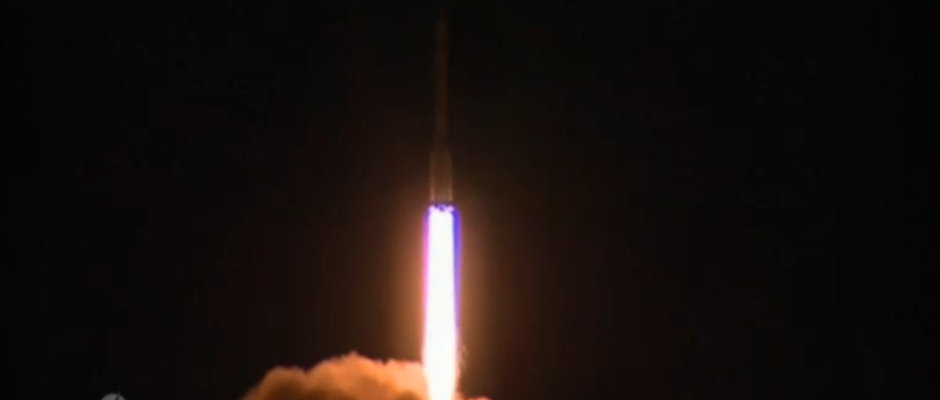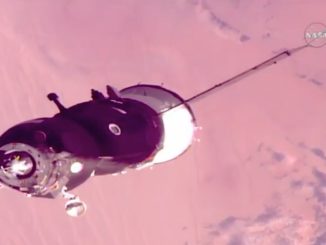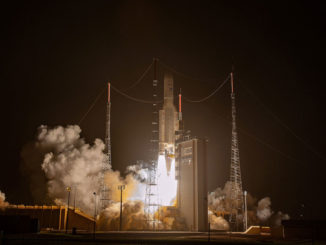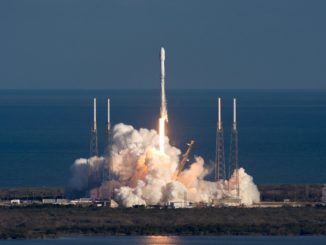Updated after spacecraft separation.
A Russian Proton rocket boosted a Turkish telecommunications satellite into space Friday after a blazing liftoff from Kazakhstan, and a Breeze M upper stage injected the 5.4-ton broadcasting craft into an orbit ranging more than 20,000 miles above Earth nine hours later.
The Turksat 4B satellite — encapsulated in the nose cone of the 19-story Proton booster — blasted off at 2040:11 GMT (4:40:11 p.m. EDT) Friday from the Baikonur Cosmodrome, riding a column of orange rocket exhaust through low clouds hanging above the arid space center.
After pitching on a northeast trajectory from Baikonur, the Proton rocketed through the speed of sound and shed its six-engine first stage in the first two minutes of the flight.
The Proton’s second and third stage engines, all burning a noxious mixture of hydrazine and nitrogen tetroxide propellants, completed their programmed firings within 10 minutes, then deployed a battery-powered Breeze M space tug to guide Turksat 4B to its proper position in space.
An initial burn by the Breeze M’s main engine stabilized the spacecraft in a low-altitude parking orbit, and four more firings raised Turksat 4B’s altitude and move its orbit closer to the equator.
After the Breeze M’s fifth burn, the upper stage was scheduled to release Turksat 4B at 0553 GMT (1:53 a.m. EDT) Saturday.
Produced by Khrunichev State Research and Production Space Center, the Proton/Breeze M vehicle will target deployment of Turksat 4B in an elliptical orbit with a high point of 22,236 miles (35,786 kilometers), a low point of 5,767 miles (9,281 kilometers), and an inclination angle of 13.2 degrees to the equator.
The mission’s target orbit numbers were published by International Launch Services, the Proton’s U.S.-based marketing and sales firm. ILS confirmed the successful deployment of Turksat 4B early Saturday.
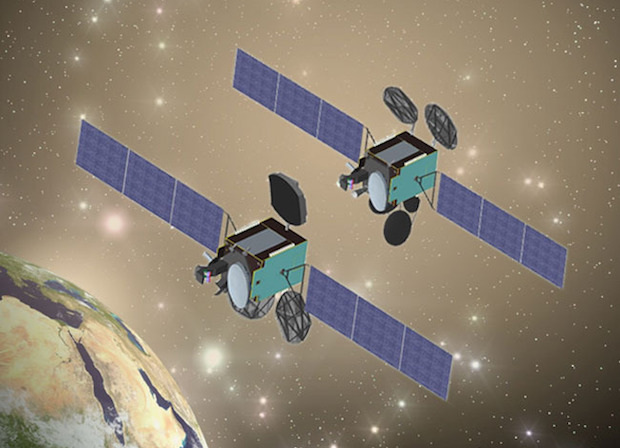
Turksat 4B’s on-board propulsion system will circularize its orbit 22,300 miles over the equator. The satellite’s owner, Turksat AS of Ankara, Turkey, said the spacecraft will complete orbital tests and be commissioned in December.
Based on the DS2000 satellite platform made in Japan by Mitsubishi Electric Corp., Turksat 4B is designed for a 15-year service life. With an on-target orbit following Friday’s launch, engineers expect the satellite will have enough fuel reserves to operate 30 years.
Turksat ordered two satellites from Melco in 2011, and the first of the pair — Turksat 4A — successfully launched on a Proton rocket in February 2014.
“We have been working on this satellite project over the last three years to get reliable, high-quality and enhanced performance products in order to provide servces for our end customers,” said Taha Tetik, Turksat’s program manager for the Turksat 4A and 4B missions.
Turksat 4B’s payload covers the Ka-band, Ku-band and C-band spectrum.
The Ka-band payload will support high-speed Internet services, adding 3 gigabits per second of capacity to Turksat’s network, according to a statement on the company’s website. The Ku-band transponders will broadcast television programming.
From a final operating post in geosynchronous orbit at 50 degrees east longitude, Turksat 4B will reach a coverage zone spanning from Europe to Afghanistan, including Turkey, the Middle East and Africa.
“I feel these two satellites are a symbol of cooperation between Turkey and Japan, as well as between our customer Turksat and Mitsubishi Electric,” said Yoshiaki Nakatani, Melco’s senior vice president and president of the company’s electronic systems group. “We are very proud to contribute to the Turkish communications infrastructure with our reliable space technology.”
Yasunori Kamochi, general manager of Melco’s space systems division, said the Turksat 4B spacecraft will reach geosynchronous orbit six days after launch, then will be handed over to Turksat after the end of in-orbit testing.
The satellite’s solar panels and antenna reflectors will also be unfurled.
Friday’s flight marked the 407th launch of a Proton rocket since its debut in 1965, and the sixth Proton mission of 2015. It was the 91st Proton launch for a commercial customer under the auspices of International Launch Services.
Email the author.
Follow Stephen Clark on Twitter: @StephenClark1.

